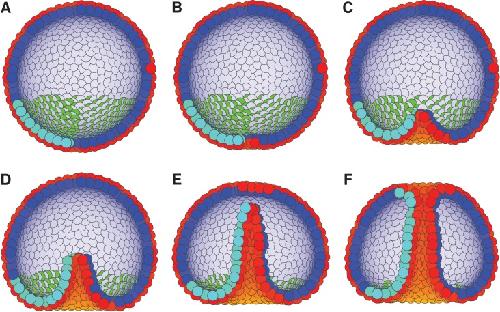ECB-IMG-185664
Echinobase Image ID: 185664

|
|
Figure 7. External constraints on apical-basal (AB) polarity and planar cell polarity (PCP) can initiate invagination and drive gastrulation in sea urchin.(A) The lower third of the cells in a blastula with AB polarity (apical is blueâwhite, basal is redâorange) pointing radially out acquire PCP (cyanâgreen) in apical plane pointing around the anterior-posterior (top-bottom) axis (as in the inset to Figure 6). (B) Flattening of the blastula and (C) invagination occur due to external force reorienting AB polarity (Materials and methods). (DâE) Tube elongation is due to PCP-driven convergent extension and (F) merging with the top of the blastula happens when the tube approaches the top. Throughout the simulation, λ1 = 0.5, λ2 = 0.4, and λ3 = 0.1 for the lower cells while the top cells have λ1 = 1 and λ2 = λ3 = 0. For full time dynamics see Figure 7âvideo 1. In Figure 7âfigure supplement 1, we consider alternative scenarios of sea urchin gastrulation and and neurulation. Larger Image Printer Friendly View |
